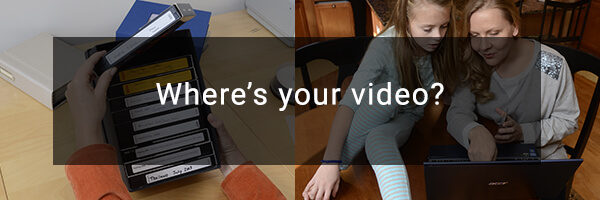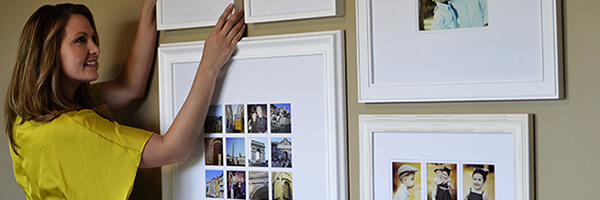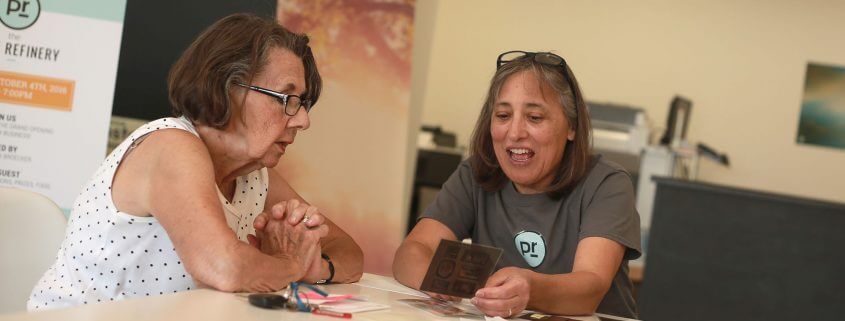Why? Because it’s not just a piece of paper, or canvas, or metal, or wood. It’s not just a photo or a graphic. It’s a conversation starter, the spark that ignites stories and creates emotional connections. It’s a mnemonic expression of the experiences that bring together families and friends, colleagues and clients. At The Print Refinery, this human connection drives the unique experiential elements that make up a winning formula – for the consumer and the retailer.
EXPERIENCE a Consultative Creative Partnership – Today’s specialty retail and service markets are no longer transactional, employing order takers. For both retail guests and commercial clients, you must develop relationships that position your team as the local expert. It’s time to get out from behind the counter and consult with each customer side-by-side. Understanding their needs and matching them with your vast capabilities will guarantee the desired end result – that emotional connection with the story behind the project.
The Print Refinery store design incorporates several multi-functional areas: a casual conversation area, a consultation counter, various styles of workstations and multiple collaboration tables. Guests and team members spontaneously engage with each other in a variety of ways, without the barrier of the traditional sales counter. The incorporation of the collaboration tables has proven to successfully increase sales tickets.
CURATE Unique Product + Service Offerings – Offering exclusive products and services with a, “We print ANYTHING on EVERYTHING,” mantra is essential, highlighted by beautiful, clean displays that thoughtfully represent the best of what you can do. Design these vignettes to feel like a home or office environment. When paired with conversation, your team will utilize the free flow environment to walk guests through a hands-on experience of examples, materials and inspiration that meets their specific needs. Embracing the latest marketing techniques (web design, online advertising, digital signage, emotional messaging and video), as well as adding celebratory packaging, emphasizes the perception of your work being professionally crafted, custom masterpieces.
The Gather Box (shoebox scanning reinvented) is one of the more multi-faceted “Signature” services offered in-store at The Print Refinery, as it encourages add-ons, upselling and derivative creative products, and can be paired with classes, events and one-on-one consultations. Ongoing development of new Signature Products and services is inspired by home and commercial décor trends and top selling items on creative sites like Etsy.
ENGAGE through Community-Building Classes + Events – Focus on building a local culture through interactive education and social events. Collaboration tables can be moved together and placed in front of a wall-mounted monitor to create an in-store classroom space. All classes and events should conclude with the creation of a printed creative product and an introduction to the endless future project possibilities. Maximize your opportunities to support, train, educate, coach and entertain your customers. Events and education inspire creativity, collaboration and connection, teaching skills that add value and lead to purchases. Capitalize upon the current popularity of group activities like paint night, plant night, trivia night, etc. that allow guests to socialize with like-minded individuals in a fun and nurturing environment.
UNCOVER High Profit Margins with Commercial Concentration – The Print Refinery is a hybrid model of equal B2C and B2B sales, using the Creative Partner Program method to attract lucrative commercial projects that carry an 80% margin on average. Developing creative partnerships with local businesses happens mostly outside of the store, however, the store is well-equipped with interactive displays and collaboration areas for in-store appointments, as well as spontaneous experiences. This new focus has brought one location over $20,000 in additional sales in January of this year.
CULTIVATE Team Culture – Your brand = your culture = your team. These three elements must be well developed, communicated and integrated. Start by clearly defining your brand culture through your vision, mission, guiding principles (core values) and brand promise. All business decisions are tested against these, including cultivating the right team. Engaged team members are attracted to your culture and perform better as a result. Engagement starts during the recruiting process and continues through interviewing, hiring and training. Most importantly, it never ends with growth opportunities presented by coaching, mentoring and education. State your vision, mission, guiding principles and brand promise and clearly define the attributes of your ideal team member in your job descriptions and training materials.
The Print Refinery Vision:
“Building a passionate local community by inspiring people and businesses to creatively use photographs, imagery and video.”
DEVELOP a New Mindset – Training is integral in making the culture shift of taking your team members from order takers to collaborators, from producers to artisans, from service representatives to educators, and from retail salespeople to commercial partners. The Print Refinery developed an online training program in which all team members from all stores participate. It can be modified for use during in-person individual or group training. Training modules are added regularly to introduce new concepts and train on the brand, the culture, sales techniques, display methods and new products and services.
The Print Refinery Brand Promise:
“Our passion is bringing your stories to life through artistic collaboration. Our obsession is delivering share-worthy excitement with each experience and project.”
Because at the end of the day, when you present your hand-crafted masterpieces to your in-store guests and unveil your stunning on-location installations to your creative partners, you’ve become an irreplaceable part of their storytelling process. You are now part of their conversation. You’ve forged a lasting connection. Consult. Create. Repeat.







